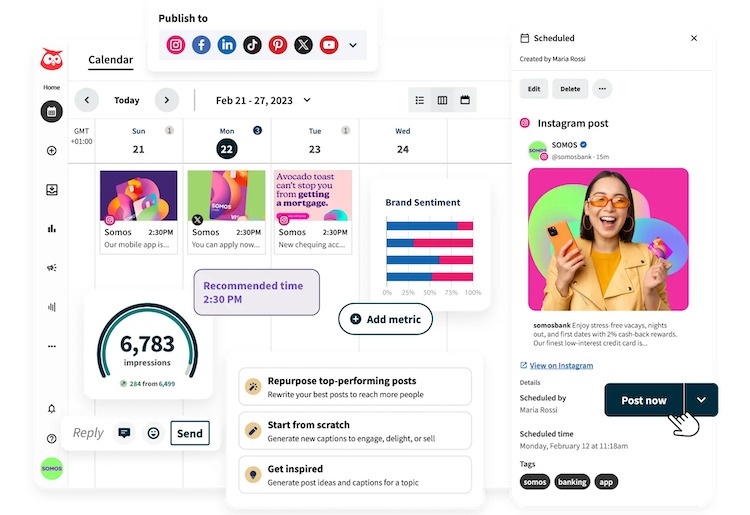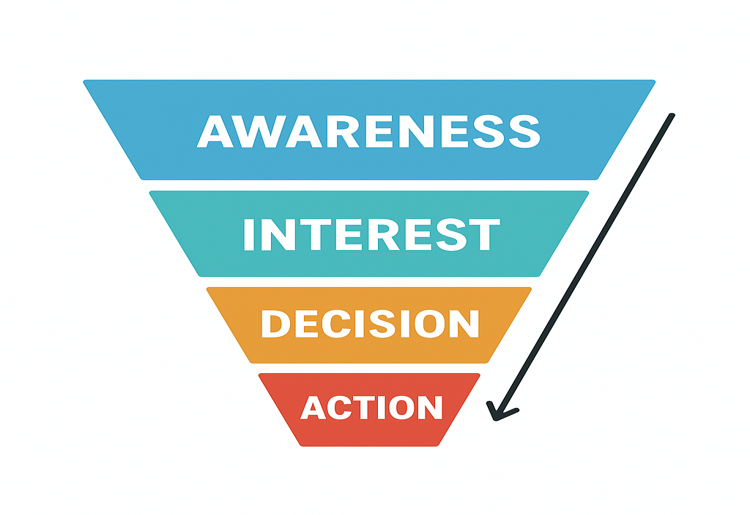With so many options such as Instagram, TikTok, and LinkedIn, it’s easy to feel like you need to be everywhere, all the time. But that’s just not realistic. In fact, many business owners get caught up in chasing likes and followers, forgetting that social media is just one piece of a bigger picture — building genuine connections, growing your brand, and supporting your business goals.
If you’re feeling unsure where to start or how to make your efforts count, this guide will help you identify which platforms are best suited for your type of content and the goals you want to achieve.
Choose One Platform And Start There
It’s no surprise that social media can be an incredibly effective marketing tool. In fact, 76% of SMBs say social media improves their business performance, Lifewire reported. In 2025, social commerce is expected to make up a total of 20 percent of total ecommerce, according to Statista.
While it’s tempting to be everywhere at all times when you’re starting a business, it’s important to be realistic about how much energy and time it takes to use social media effectively.
Being effective on social media requires showing up consistently. That takes time, energy, content strategy, and the right systems. You have to continually post and engage to see results, not to just post “when you feel like it”. That’s why it’s best to choose one platform and become an expert in it specifically.
If you’re thinking, “Yeah, but how do I choose?”, the chart below will help you get started. The best choice will align with your business niche, your personal voice, and your preference for how you like to share content (such as text, photos or videos).
Overview of Social Media Platforms to Help You Choose One
Social Media Platform | Best for | Ideal content type | Additional things to consider |
Consultants and coaches working with larger companies and brands, B2B services, agencies, SaaS, thought leaders | Thought leadership posts, articles, carousels, video | Best for professional visibility and networking | |
X (formerly Twitter) | Journalists, media, fast news, startups, tech, commentary brands | Short text posts, threads, links, memes | Best for real-time trends and building niche authority |
Local businesses, community-based orgs | Events, live video, community groups | Facebook could be a good place to advertise if you already have a large network on the platform | |
Lifestyle brands, creators, wellness, fashion, food, solopreneurs | Reels, stories, product photos, carousel posts | Highly visual, great for storytelling | |
Threads | Creators, culture/media commentary, brand personality, real-time talk | Text-first posts, commentary | Still an emerging platform. It’s particularly useful for personality-driven and culture-based brands |
Product-based businesses, home, beauty, DIY, food, weddings | Pin graphics, blog links, and how-to content | Strong for evergreen traffic and purchase intent | |
TikTok | Creatives, educators, entertainers, personal brands | Short-form personality-driven video, trends, tutorials, and behind-the-scenes content | The algorithm favors authentic, fast-paced content |
How to Choose the Right Platform for You and Your Business
Social media isn’t just about creating a content plan. It’s also about having something to say that you’re proud of sharing. If you’re a small business owner only starting to build up your network, here are a few questions to ask yourself.
Who Are You Trying to Reach?
Your target audience should be one of the biggest factors in your platform choice. Let’s be honest, you could post the most compelling thought leadership content on LinkedIn, but if you’re ideal clients don’t hang out there, they won’t see it.
Consider your audience before making a choice. For example:
If your ideal customers are professionals or other businesses, consider LinkedIn. This includes consultants, B2B service providers, corporate coaches, and anyone selling to decision-makers within companies.
If you're targeting younger consumers (Gen Z and younger millennials), TikTok and Instagram are where they're most active. This works well for lifestyle brands, entertainment, fashion, and consumer products.
If your audience includes busy parents, local community members, or individuals over 35, Facebook still has strong engagement in these demographics, especially for local businesses and community-focused brands.
If you're reaching hobbyists, DIY enthusiasts, or people actively shopping for products, people use Pinterest for inspiration and often have high purchase intent.
What Do You Like to Create?
This question is often overlooked. At the end of the day, you are going to be the one creating content (unless you hire someone), so it’s important that you actually enjoy the process to a certain degree. For example, if you dislike being on video, TikTok may not be the best platform for you, even if it's a perfect fit for your audience.
If you love writing and sharing insights, LinkedIn, X, and Threads are text-friendly platforms where thoughtful posts perform well. You can share opinions, thought leadership posts, and engage in meaningful conversations. X and Threads also work well for immediate, conversational content that doesn't require heavy planning or production.
If you're naturally comfortable on camera and enjoy creating videos, consider TikTok or Instagram Reels. These platforms reward personality-driven, authentic video content over polished production.
If you enjoy taking photos and love visual design, Instagram or Pinterest are good choices for aesthetic content.
How much time do you realistically have?
It’s easy to underestimate the time it takes to successfully utilize a social media platform and start seeing results. It’s tempting to say, “Oh, I’ll just post when inspiration strikes. I have so many ideas, it won’t be an issue.” But what happens when your schedule is fully booked with client and admin work? Are you really going to remember to dedicate time to social media content when it’s the least urgent item on your to-do list?
That’s why it’s so important to plan in advance. Social media requires engagement. That includes responding to people’s comments on your posts, other people’s posts, and messages you receive (you can see how these tasks alone can easily snowball into multiple hours a week).
If you have 2-3 hours per week, focus on platforms where you can batch content creation. Pinterest and LinkedIn allow you to create content in advance and post less frequently but still maintain engagement. You can dedicate 2 hours to content creation and 1 hour to engagement.
If you can dedicate 5-7 hours per week, Instagram or TikTok become more manageable, since these platforms benefit from more frequent posting and real-time engagement, but they can also drive significant results.
If you have very little time but want some social presence, consider X or Threads, where quick, authentic posts can be effective and don't require time-intensive production.

Image: Tools like Hootsuite can help you schedule your social media posts in advance and track each post’s performance.
Additional Tips to Make the Final Decision
Remember that you can always add another social media platform, but it’s beneficial to have a solid presence on one platform before starting another.
Be patient. Most platforms take 3-6 months of consistent posting to see results. If you switch platforms after a few weeks because you’re frustrated it’s not working, you won’t see the benefits of your effort.
Focus on engagement over follower count. Follower count has become the go-to metric for determining someone's level of establishment. But the truth is that your engagement is much more relevant and important to your business. You could have 50,000 followers, but if none of them are ideal customers, it won’t impact your bottom line.
Direct followers to your sales funnel. Social media is great for increasing awareness in the sales funnel, but you don’t want people to linger there forever. You want to move people from awareness to interest and consideration. If you see that your followers are increasing but your leads, sales calls, and actual sales are not, it’s time to adjust your social media strategy.

Image: Social media is good or the awareness phase of the marketing funnel, but you want to make sure you’re directing people towards interest, decision and action.
Pick One Social Media Platform and Commit
The best social media platform for you and your business is the one where your ideal customers spend time, you enjoy creating content, and you can realistically maintain a consistent presence. If you choose based on these factors and commit to it for at least six months, you’ll likely be surprised by the progress you make in a short time.
Keep in mind that you don't have to be on social media to have a successful business. But if you decide to, using the right platform strategically can help you reach your marketing goals.


